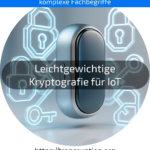Lightweight cryptography for IoT is an important term in the areas of Internet of Things, cybercrime and cybersecurity as well as Industry and Factory 4.0.
The Internet of Things (IoT) refers to many small devices such as sensors, smart lamps or thermostats that communicate with each other. These devices often have little memory and computing power. Normal encryption, such as that used on computers, is too cumbersome for these miniature devices. This is where lightweight cryptography comes into play: it protects data using specially developed, particularly "light" and fast encryption methods that also work on small chips.
Imagine small sensors regularly measuring the temperature in a factory. If this data were transmitted unencrypted, hackers could intercept or modify it. Thanks to lightweight cryptography, the information sent is encrypted without the sensor requiring too much energy or power. This keeps the factory secure and the data confidential.
This encryption therefore helps to effectively protect the growing world of IoT devices against cybercrime, even if the individual devices are very simply built.






